

Repeat a lie enough times and what do you have? Another lie. There are numerous myths, legends and lies regarding trout and fishing for them. Here are a few to chew on:
1. Eyes on streamers provoke strikes
It is widely held that predatory fish key in on and attack the eyes of bait fish. As “proof” many anglers cite the presence of ocelli or false eyes near the tail of some fish. They contend the predator will target these eyes and the attack will be directed toward the tail.
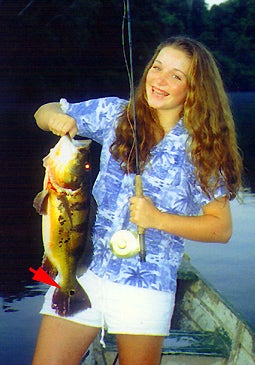

Studies around the world with numerous species of fish show that that predatory fish do not aim for the eyes. In every instance the mid section of the prey was targeted. The size, shape, location, presence or lack of the eyes (or ocelli) in no way altered the point of the attack.
Researchers have found that very often a predatory fish will not attack if the eyes are visible. Time after time bass, pike and barracuda have been observed rushing past available bait to take a fish with it’s back turned. It seems predators have learned they can get the jump on their prey when it’s not looking
Ocelli located near the tail of bait fish may give the impression it is “looking” when its back is turned and avoid being attacked. For the same reason eyes on a streamer may actually be counter productive.
There is no doubt some flies are more effective with eyes than without. Eyes can add both physical and visual balance to a fly. The eyes may add just that certain bit of spark, brightness or contrast that makes the pattern irresistible. In certain patterns, eyes impart action and even noise to a streamer. Blanton’s Whistlers and Clousser’s Deep Minnows are good examples; exchange the lead eyes on a Deep Minnow with plastic eyes and the fly loses both its jigging action and fish catching qualities.
2. Approach from behind (usually from downstream) to sneak up on trout.
Trout have a perfect 360 degree view of their environment. They not only see forward and well to the sides, they continual scan the reflective underside of the water’s surface to watch for anything approaching from behind.
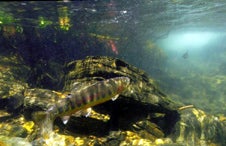

A trout’s eyes are placed high on the sides of its head. Its blind spots are immediately in front of its nose and for a few inches directly behind its tail. A trout’s ceiling is a huge mirror that allows it to see reflected images that are hidden from direct line of sight. In short, it’s pretty darned hard to sneak up on a trout unannounced from any direction. Luckily, if approached with respect, trout don’t care.
If we act non -threatening, the fish will almost always accommodate our presence. An analogy most people can relate to is a deer in a meadow. You can walk quietly along the perimeter of the meadow and usually the deer will give a good stare then continue to browse with an occasional glance. If you stop and do jumping jacks, the deer will become a blur.
Move slowly, don’t needlessly false cast or wear clothes that flap in the breeze. Watch the fish. When it starts to sink to the river bed, fold its fins or increase its rate of tail beats, stop whatever you’re doing and allow the fish to relax. If it bolts, move into position and wait. The fish will usually return and begin feeding in short order.
3. Small tippets are better because they are harder to see.
Two fishing rods viewed from a trout’s perspective. The white one blends with the sky while the dark one stands in sharp, threatening contrast.
This one defies common sense. Switching from a 5X to a 7X tippet is making a change of two thousands of an inch in line diameter. Do you really think trout can tell the difference?


On Fall River and Fort Creek I’ve glued foot long pieces of 15 pound Maxima to Hexagenia mayflies and grasshoppers. These notoriously selective fish rose to the bugs without hesitation, yet they turned away from the same fly attached to 5X tippet connected somewhere upstream to a fly rod.
The difference, and the only difference, is drag. It is amazing how much junk is floating in the water in and amongst trout food. If the trout rejected every item near a pine needle or piece of straw, the fish would starve to death. Trout are not accustomed to seeing a mayfly spinner swimming upstream or an ant skating sideways.
The thinner the tippet, the less drag it is inclined to impart on the fly. You can also reduce drag by lengthening the tippet or by affixing the fly with an open loop knot.
4. You must match the color of the prey.
Anglers are easily seen by fish. Luckily for us fish don’t care and if the angler moves in slow unthreatening fashion, even the most wary fish will resume feeding.
What a crock. Trout see every color we do, plus they can see infra red and ultra violet. When we see a green caddis larvae, we are seeing an object that is absorbing all the visible wavelengths of light except blue through yellow. These colors are reflected in a blend of light that appears as green to the human eye.
What if this caddis is also reflecting ultra violet? It’ll still look green to us because we can’t see UV. To the trout that can see into the ultra violet spectrum, the caddis will look something far different from green.
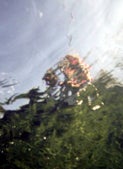

Out of a laboratory we have no way of knowing how trout perceive a bug. Luckily, it doesn’t matter. Trout don’t care (it takes a brain to care) if the fly contains the wrong color. Blend lots of colors into your dubbing . . . as long as the right color is present, most fish selectively discriminate against the wrong colors and take the bug. Whitlock’s “bright dot” flies are a perfect example of this.
5. The best trout hold in pockets behind rocks.
While it is very true that lots of good trout are taken behind rocks, the better trout is invariably in front of the rock.
When water strikes a flat fronted barrier such as a rock, it folds back on itself and creates an area of calm called a pillow. This in-front-of-the-rock pillow is not nearly so obvious as the big bold eddy behind the rock. This pillow creates a prime lie. The calm allows the trout to maintain position without burning many calories. It is well hidden from terrestrial predators such as ospreys and twelve year old boys with worms because the boiling water of the pillow breaks up the trout’s image. If aquatic enemies like otters and mergansers approach, the trout merely has to poke its head into the current rushing around the rock and be swept into sanctuary.
Best of all, the fish has first crack at food drifting downstream. When a bug drifts into the face of the rock it will bobble in the pillow, allowing the trout to inspect then eat it at her leisure.
6. Loud noises scare fish.
Some noises do scare fish. Mike Lawson, whom I respect deeply, swears that wise old trout on the Henry’s Fork will spook at the sound of line being stripped off a reel. I believe him.
In most waters however, trout don’t care if you talk to yourself, crunch gravel underfoot or allow your aluminum wading staff to clink along the bottom. I’ve crawled up behind trout and banged rocks together and repeatedly whacked a heavy knife butt against my SCUBA tank. The fish took absolutely no notice.
It is really noisy underwater, a regular cacophony of swirling gravel, banging rocks, drifting bits of garbage and the constant hiss and roar of seething water. Fish would go nuts if they spooked every time the current rolled over a stone. Except for humans and bears, I can’t think of any trout predator that might make its self known by kicking over river rocks.
It is probably for this reason that fish evolved without ears. In lieu of ears trout have extremely sensitive pressure receptors called lateral lines. Fish do care when you slosh or create any kind of ripple or wake that is incongruous with the normal background pattern of pressure waves.
7. Heavy lines cast into the wind better than light ones.
This one would seem to make sense, just like it would seem to make sense for a big cannon ball to fall faster than a little cannon ball. There are a couple things working against a heavy flyline.
Line diameter. The air resistance against a fat cross section of line more than makes up for the increased mass. Once you shoot the line, the buffeting of wind rapidly decreases the line’s velocity (and accuracy) and it falls out of the sky. Weight. Any given rod is designed to hold a certain amount of line weight in the air. A six weight rod, for instance, optimally loads at about 160 grains which is just about what 30 feet of six weight flyline weighs. How about that.
Since it is the shooting part that gets most people into trouble in a windy situation, it makes sense that the more line we can carry, hold and power through the air with the rod, the better off we’ll be. It takes 55 or 60 feet of three-weight line to weigh 160 grains. If you replace your six-weight line with a three weight, the rod doesn’t care. All it knows is that it is now holding 55 or 60 feet of line in the air rather than 30. That’s 30 feet you won’t have to shoot. As an added bonus, the three-weight line has a much smaller diameter so it doesn’t face as much air resistance.
8. Nymphs should be weighted.
Not only do I NOT put weight in my nymphs, I treat them with floatant to make them bouyant. The split shot carries the nymph to a trout’s level where the nymph can then move about in the current like a natural insect. Notice how the bubbled encrusted nymph (white arrow) is floating above the orange split shot (red arrow).
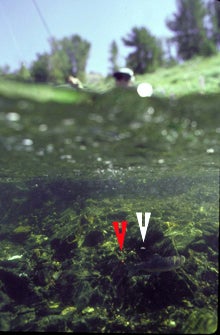

Now imagine a spark plug.
An unweighted nymph imitation much more closely approximates the behavior of a real nymph in the current. People are fanatics about presentation when their fly is drifting on the film but become complacent when fishing nymphs. Out of sight out of mind I guess.
Put enough split shot on your leader (maybe two inches from the imitation) to take the nymph down, but once down, let nature take its course with your bug. I go so far as to treat my nymphs with fly floatant to increase their buoyancy.
9. Trout are afraid of split shot/indicators placed close to a fly.
Trout are NOT afraid of split shot crimped close to a fly. This golden trout is inhaling a bubble cloaked nymph (under white arrow) which is only a couple of inches from a bright orange split shot (under the red arrow).
Set you up for that one! As we discussed under item 3, Invisible Tippets, trout are used to seeing tons of junk drifting downstream and can’t possibly reject every food item that might happen to be drifting along side a non-edible item.
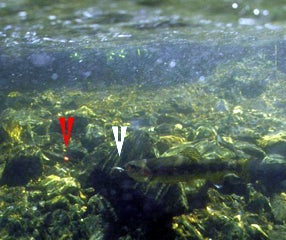

What if that split shot did look out of place? Well, the trout don’t care (some one make me a bumper sticker). I keep a stash of shot dipped in hot orange vinyl for those times when I want to see the fly (always). The highly visible weight allows me to accurately judge a drift or to see the split-second a trout inhales the bug. Very often the fish will ignore the bug and inhale the glowing split shot instead
10. Keep your indicator floating drag-free on the surface.
If you’re fishing in 12 inches of water, yes this is true. In water knee deep and beyond, you’re blowing the presentation by having the indicator drift with the film.
Because of friction exerted by the substrate, water just above the streambed is moving pretty slowly. In fact, for the first couple of millimeters (called the boundary layer), the water isn’t moving much at all. Even in tumultuous water, nymphs drifting along the streambed are traveling at a modest speed.
If your indicator is drifting drag free on the surface, rest assured your nymph is being ripped along the bottom at a most unnatural rate. While it’s true many trout are somehow fooled by this presentation, many others aren’t.
Keep your rod upstream of the indicator and every second or so, pull back just enough to create a “V” wake on the upstream side of the indicator. This will slow down the nymph. After a second of holding the indicator back, give it a bit of slack. This will allow the nymph to fall back to the bottom. (If you don’t hang up your split shot, you’re not using enough). This method will keep the nymph in the feeding zone, will keep it drifting at a natural rate, will give it enticing action as you mini-mooch it and will instantly increase your success.
Here are few more ponderables. Come to your own conclusions. Pretend you’re underwater.
1. Always approach fish with the sun at your back. Clue: What happens with high beamed headlights in the fog?
2. Dark colored lines are harder for fish to see. Clue: What color are the undersides of predatory birds like ospreys and mergansers?
3. Fish always face upstream. Clue: Who was Beaver Cleaver’s delinquent friend?











